1994 PONTIAC BONNEVILLE engine oil
[x] Cancel search: engine oilPage 153 of 290
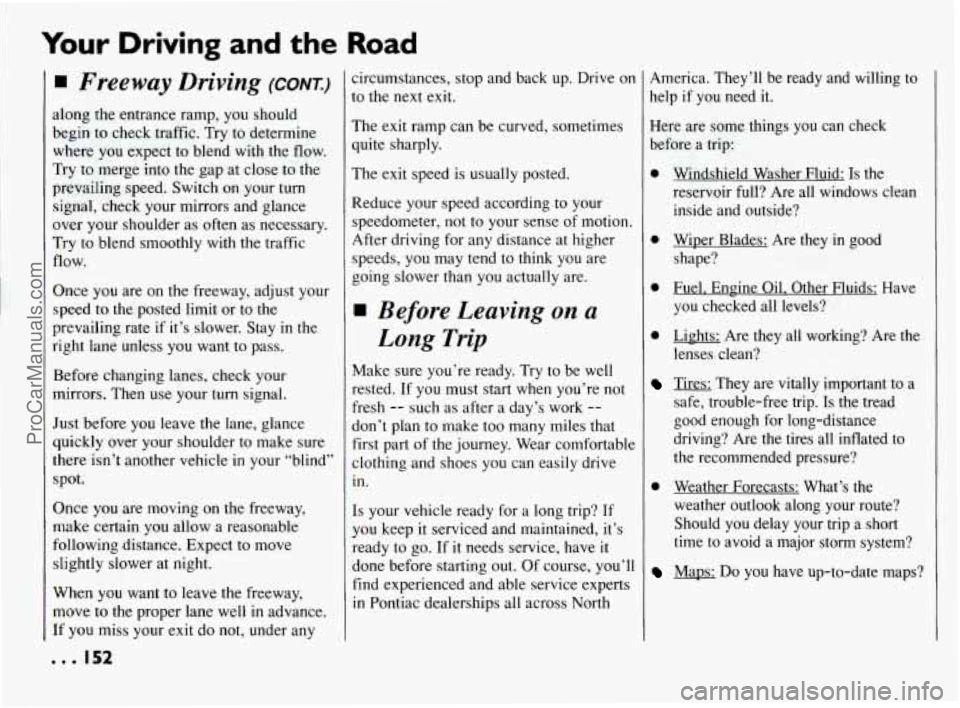
Your Driving and the Road
H Freeway Driving (CONK)
along the entrance ramp, you should
begin to check traffic. Try to determine
where you expect to blend with the flow.
Try
to merge into the gap at close to the
prevailing speed. Switch on your turn
signal, check your mirrors and glance
over your shoulder as often as necessary.
Try to blend smoothly with the traffic
flow.
Once you are
on the freeway, adjust your
speed to the.posted limit or to the
prevailing rate if it’s slower. Stay in the
right lane unless
you want to pass.
Before changing lanes, check your
mirrors. Then use your turn signal.
Just before you leave the lane, glance
quickly over your shoulder to make sure
there isn’t another vehicle in your “blind”
spot.
Once you are moving
on the freeway,
make certain you allow a reasonable
following distance. Expect to move
slightly slower at night.
When you want to leave the freeway,
move to the proper lane well
in advance.
If you miss your exit do not, under any
,.. 152
circumstances, stop and back up. Drive on
to the next exit.
The exit ramp can be curved, sometimes
quite sharply.
The exit speed
is usually posted.
Reduce your speed according to your
speedometer, not to your sense of motion.
After driving for any distance at higher
speeds, you may tend to think
you are
going slower than you actually are.
Before Leaving on a
Long Trip
Make sure you’re ready. Try to be well
rested.
If you must start when you’re not
fresh
-- such as after a day’s work --
don’t plan to make too many miles that
first part
of the journey. Wear comfortable
clothing and shoes you can easily drive
in.
Is your vehicle ready for a long trip? If
you keep it serviced and maintained, it’s
ready to go. If it needs service, have it
done before starting out. Of course, you’ll
find experienced and able service experts
in Pontiac dealerships all across North America. They’ll
be ready and willing to
help if you need it.
Here are some things
you can check
before a trip:
0 Windshield Washer Fluid: Is the
reservoir full? Are all windows clean
inside and outside?
0 Wiper Blades: Are they in good
shape?
0 Fuel. Engine Oil. Other Fluids: Have
you checked all levels?
0 Lights: Are they all working? Are the
lenses clean?
Tires: They are vitally important to a
safe, trouble-free trip.
Is the tread
good enough for long-distance
driving? Are the tires all inflated to
the recommended pressure?
0 Weather Forecasts: What’s the weather outlook along your route?
Should you delay your trip a short
time to avoid a major storm system?
Maps: Do you have up-to-date maps?
ProCarManuals.com
Page 164 of 290
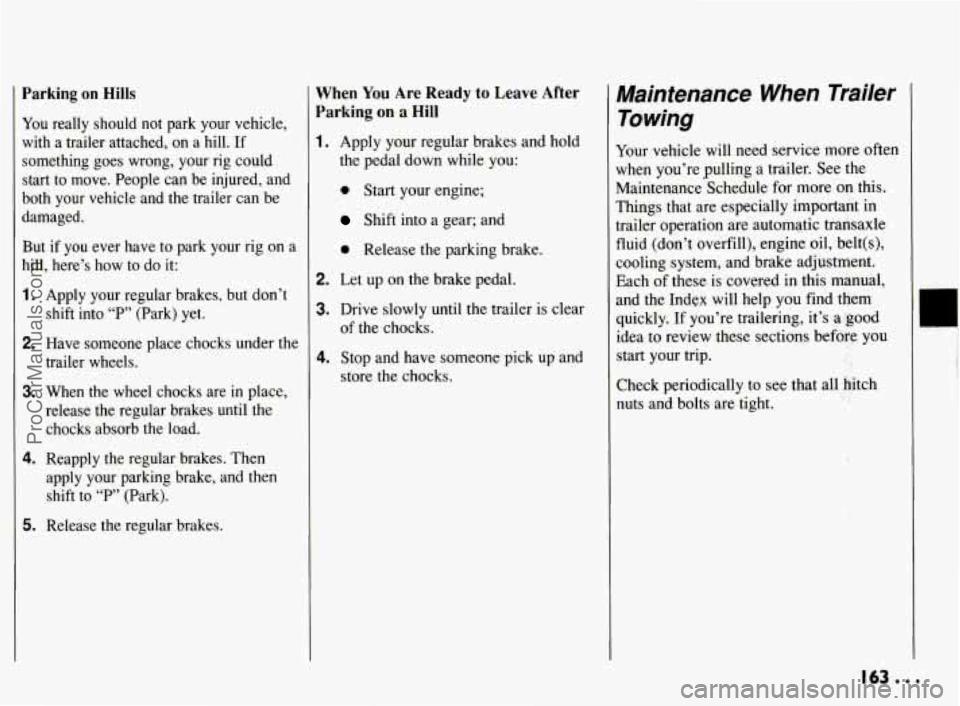
Parking on Hills
You really should not park your vehicle,
with a trailer attached, on a hill.
If
something goes wrong, your rig could
start to move. People can be injured, and
both your vehicle and the trailer can be
damaged.
But if you ever have to park your rig on a
hill, here’s how to do it:
1.
2.
3.
4.
5.
Apply your regular brakes, but don’t
shift into
“P” (Park) yet.
Have someone place chocks under the
trailer wheels.
When the wheel chocks are in place,
release the regular brakes until the chocks absorb the load.
Reapply the regular brakes. Then
apply your parking brake, and then shift to
“F”’ (Park).
Release the regular brakes.
When You Are Ready to Leave After
Parking
on a Hill
1.
2.
3.
4.
Apply your regular brakes and hold
the pedal down while you:
0 Start your engine;
Shift into a gear; and
0 Release the parking brake.
Let up on the brake pedal.
Drive slowly until the trailer is clear
of the chocks.
Stop and have someone pick up and
store the chocks.
Maintenance When Trailer Towing
Your vehicle will need service more often
when you’re pulling a trailer.
See the
Maintenance Schedule for more
on this.
Things that are especially important in
trailer operation are automatic transaxle
fluid (don’t overfill), engine oil, belt(s),
cooling system, and brake adjustment,
Each
of these is covered in this manual,
and the Index will help you find them
quickly. If you’re trailering, it’s a good
idea to review these sections before. you
start your trip.
Check periodically to
see that all hitch
nuts and bolts are tight.
,j.;
i .a
1. i
,
.?.
163...
ProCarManuals.com
Page 179 of 290
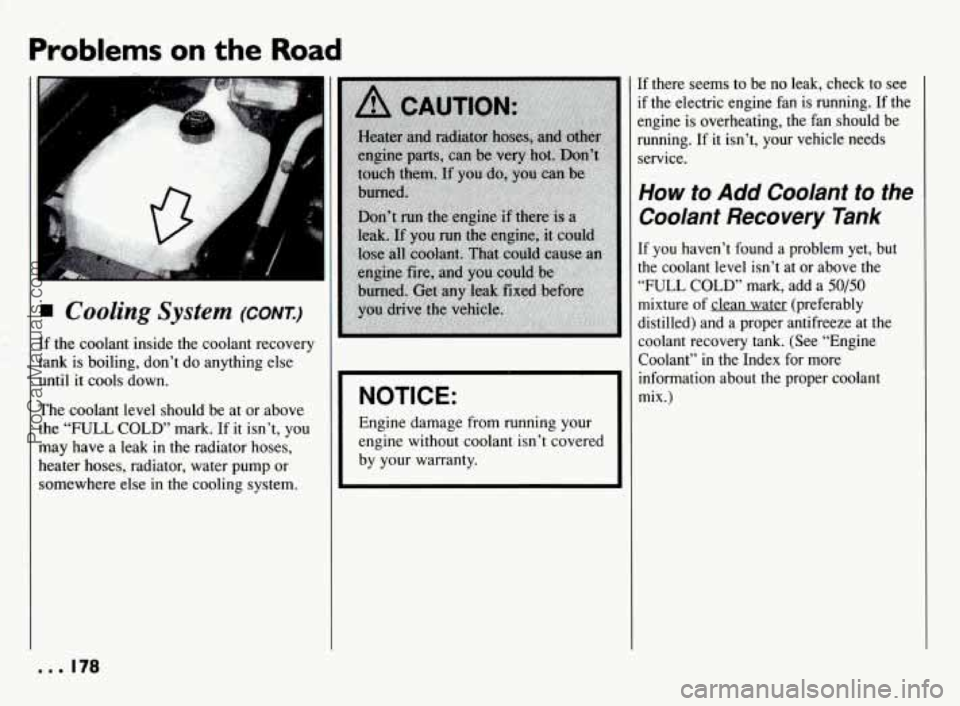
Problems on the Ro,ad
... .
I
Cooling System (CONT.)
If the coolant inside the coolant recovery
tank is boiling, don’t do anything else
until it cools down.
The coolant level should be at or above
the “FULL COLD’ mark. If
it isn’t, you
may have a leak
in the radiator hoses,
heater hoses, radiator, water pump or
somewhere else in the cooling system.
NOTICE:
Engine damage from running your
engine without coolant isn’t covered
by your warranty.
If there seems to be no leak, check to see
if the electric engine fan is running. If the
engine
is overheating, the fan should be
running. If it isn’t, your vehicle needs
service.
How to Add Coolant to the
Coolant Recovery Tank
If you haven’t found a problem yet, but
the coolant level isn’t
at or above the
“FULL COLD’ mark, add
a 50/50
mixture of clean water (preferably
distilled) and
a proper antifreeze at the
coolant recovery tank. (See “Engine Coolant”
in the Index for more
information about the proper coolant
mix.)
... 178
ProCarManuals.com
Page 197 of 290
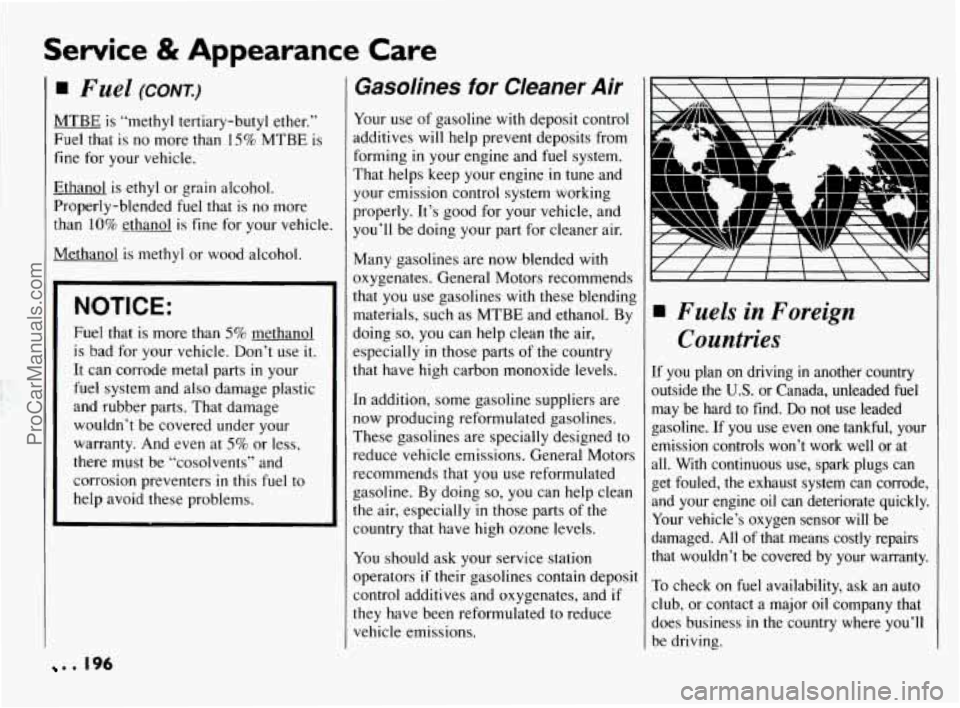
Service & Appearance Care
MTBE is “methyl tertiary-butyl ether.”
Fuel that is no more than 15% MTBE is
fine
for your vehicle.
Ethanol is ethyl or grain alcohol.
Properly-blended fuel that is no more
than
10% ethanol is fine for your vehicle
Methanol is methyl or wood alcohol.
NOTICE:
Fuel that is more than 5% methanol
is bad for your vehicle. Don’t use it.
It can corrode metal parts
in your
fuel system and also damage plastic
and rubber parts. That damage
wouldn’t be covered under your
warranty. And even at
5% or less,
there must be “cosolvents” and
corrosion preventers
in this fuel to
help avoid these problems.
Gasolines for Cleaner Air
Your use of gasoline with deposit control
additives will help prevent deposits from
forming in your engine and fuel system.
That helps keep your engine
in tune and
your emission control system working
properly. It’s good for your vehicle, and
you’ll be doing your part for cleaner air.
Many gasolines are now blended with
oxygenates. General Motors recommends
that you use gasolines with these blending
materials, such as MTBE and ethanol. By
doing so, you can help clean the air,
especially
in those parts of the country
that have high carbon monoxide levels.
In addition, some gasoline suppliers are
now producing reformulated gasolines.
These gasolines are specially designed to
reduce vehicle emissions. General Motors recommends that you use reformulated
gasoline. By doing
so, you can help clean
the air, especially
in those parts of the
country that have high ozone levels.
You should ask your service station
operators
if their gasolines contain deposit
control additives and oxygenates, and if
they have been reformulated to reduce
vehicle emissions.
r
Countries
If you plan on driving in another country
outside the
U.S. or Canada, unleaded fuel
may ‘be hard to find.
Do not use leaded
gasoline. If you use even one
tankful, your
emission controls won’t work well
or at
all. With continuous use, spark plugs can
get fouled, the exhaust system can corrode,
and your engine
oil can deteriorate quickly.
Your vehicle’s oxygen sensor
will be
damaged. All of that means costly repairs
that wouldn’t be covered by your warranty.
To check on fuel availability, ask an auto
club,
or contact a major oil company that
does business
in the country where you’ll
be driving.
. . 196
ProCarManuals.com
Page 202 of 290
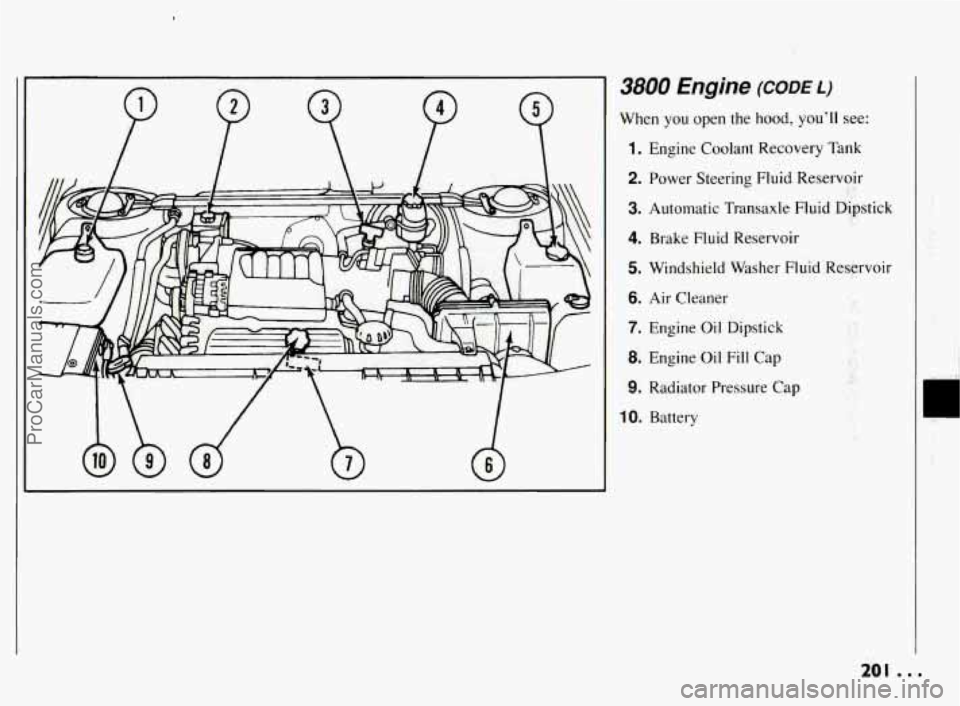
3800 Engine (CODE L)
When you open the hood, you'll see:
1. Engine Coolant Recovery Tank
2. Power Steering Fluid Reservoir
3. Automatic Transaxle Fluid Dipstick
4. Brake Fluid Reservoir
5. Windshield Washer Fluid Reservoir
6. Air Cleaner
7. Engine Oil Dipstick
8. Engine Oil Fill Cap
9. Radiator Pressure Cap
10. Battery I. .. I I 5 ;;$ " :. 1. ,.:.;
201 ..*
ProCarManuals.com
Page 203 of 290
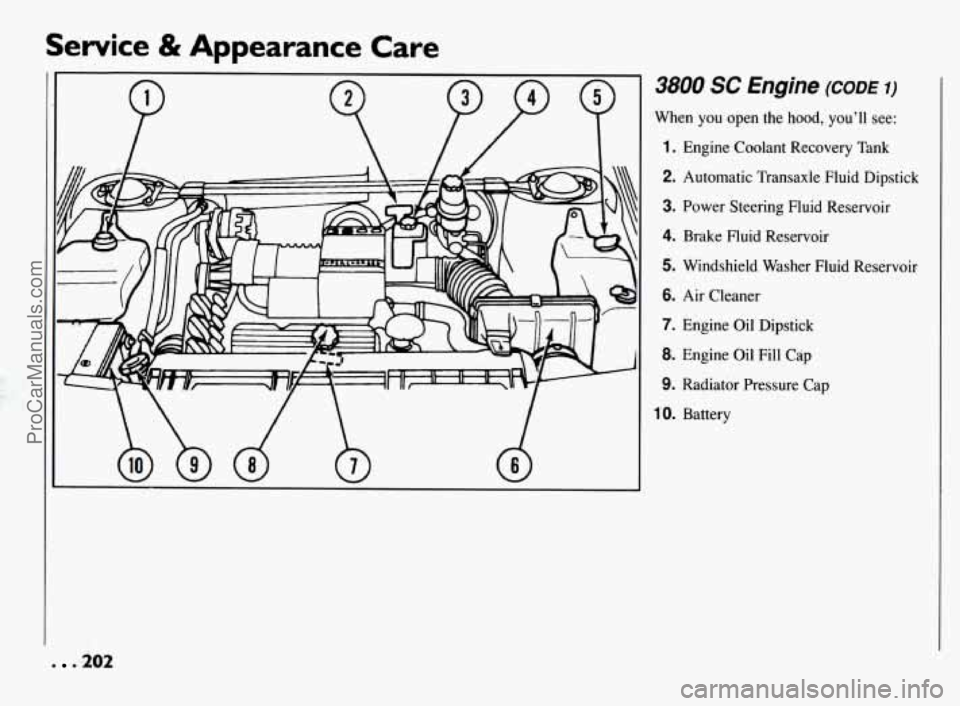
Service & Appearance Care
. 0 202
3800 SC Engine (CODE I)
When you open the hood, you’ll see:
1. Engine Coolant Recovery Tank
2. Automatic Transaxle Fluid Dipstick
3. Power Steering Fluid Reservoir
4. Brake Fluid Reservoir
5. Windshield Washer Fluid Reservoir
6. Air Cleaner
7. Engine Oil Dipstick
8. Engine Oil Fill Cap
9. Radiator Pressure Cap
lo. Battery
ProCarManuals.com
Page 205 of 290
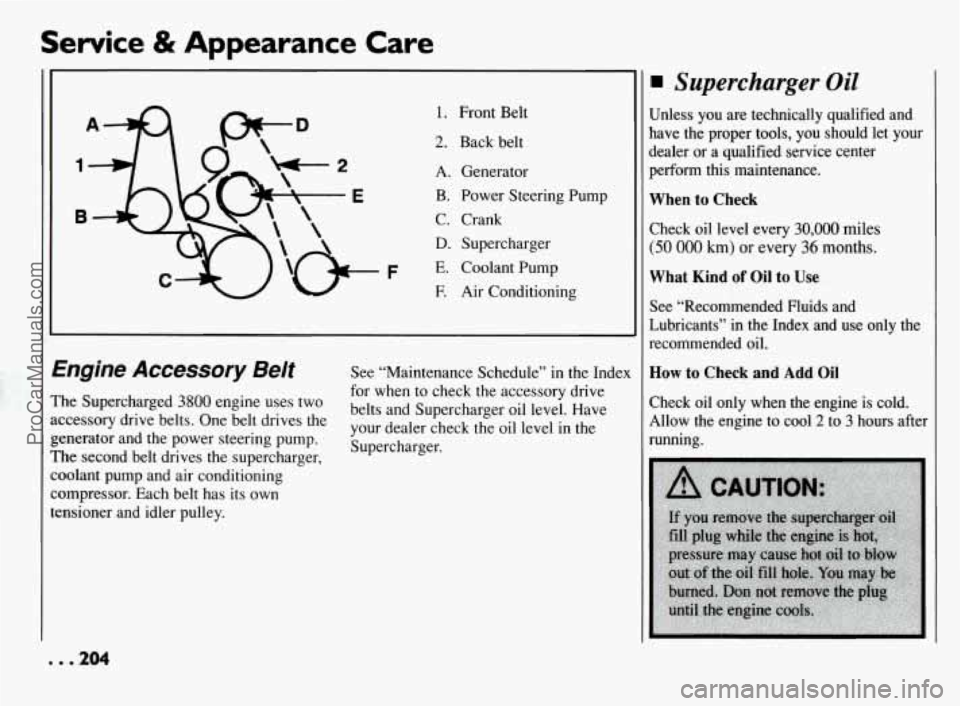
Service & Appearance Care
F
1.
2.
A.
B.
C.
D.
E.
E
Front Belt
Back belt
Generator
Power Steering Pump
Crank Supercharger
Coolant Pump
Air Conditioning
tngine Accessory Belt
‘he Supercharged 3800 engine uses two
ccessory drive belts. One belt drives the
enerator and the power steering pump.
‘he second belt drives the supercharger,
oolant pump and air conditioning
ompressor. Each belt has its own
msioner and idler pulley.
. . 204
See “Maintenance Schedule” in the Index
for when to check the accessory drive
belts and Supercharger oil level. Have
your dealer check the oil level in the
Supercharger.
Supercharger Oil
Unless you are technically qualified and
have the proper tools, you should let your
dealer or a qualified service center
perform this maintenance.
When to Check
Check oil level every 30,000 miles
(50 000 km) or every 36 months.
What Kind of Oil to Use
See “Recommended Fluids and
Lubricants” in the Index and use only the
recommended oil.
How to Check and Add Oil
Check oil only when the engine is cold.
Allow the engine to cool
2 to 3 hours after
running.
ProCarManuals.com
Page 206 of 290
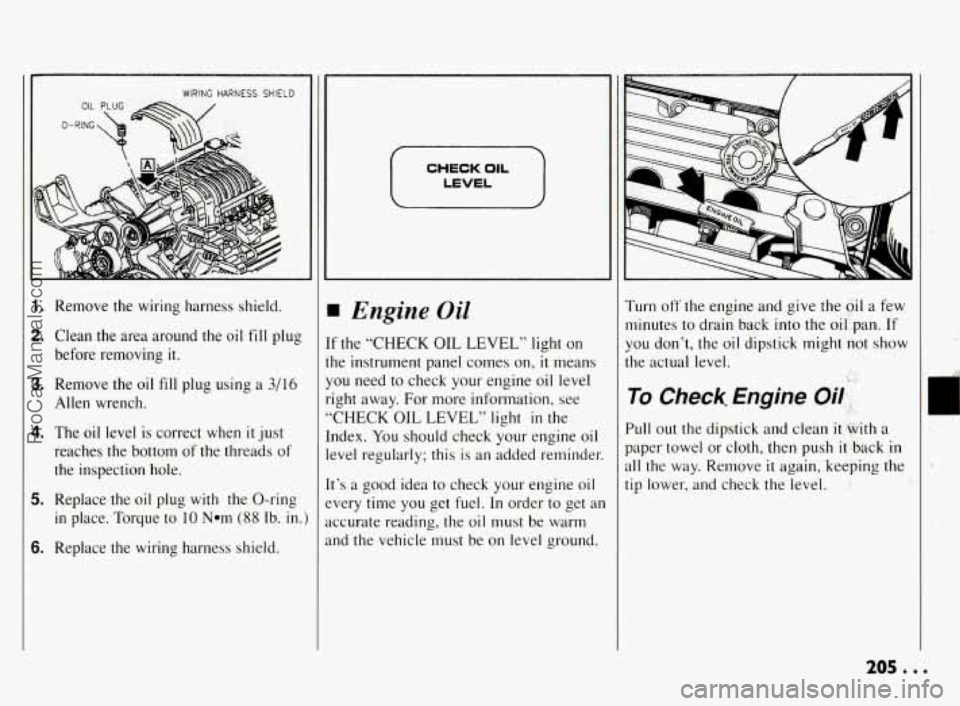
WIRING HARNESS SHIELD I
Remove the wiring harness shield.
Clean the area around the oil
fill plug
before removing it.
Remove the oil fill plug using a
3/16
Allen wrench.
The oil level is correct when
it just
reaches the bottom of the threads
of
the inspection hole.
Replace the oil plug with the O-ring
in place. Torque to
10 Nom (88 Ib. in.)
Replace the wiring harness shield.
I
I
tl
Y
r
6
1f
I1
e
a
LC
a
CHECK OIL
LEVEL
Engine Oil
f the “CHECK OIL LEVEL” light on
he instrument panel comes on,
it means
‘ou need to check your engine oil level
ight away. For more information, see
CHECK OIL LEVEL” light
in the
ndex.
You should check your engine oil
:vel regularly; this is an added reminder.
t’s a good idea to check your engine oil
very time you get fuel. In order
to get an
ccurate reading, the oil must be warm
nd the vehicle must be on level ground. Turn off the engine and
give
the oil a few
minutes to drain back into the
oil pan. If
you don’t, the oil dipstick might not show
the actual level.
To Check, Engine Oil ., I’ .
Pull out the dipstick and clean it %with a
paper towel or cloth, then push
it back in
all the way. Remove
it again, keeping the
tip lower, and check the level.
r
205 .
ProCarManuals.com